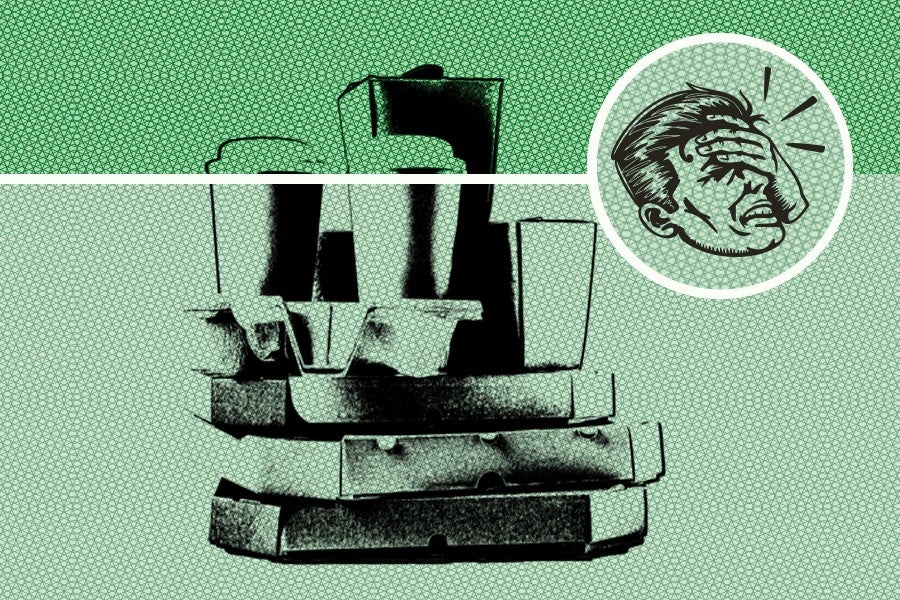Technology! It’s awesome (okay, not always.) But while big breakthroughs about the universe and stuff are great and all, how about someone put those scientific brains to work figuring out the vagaries of food delivery apps? There’s nothing in this cruel world that’s more amazing when you’re hungry and either too drunk, stoned, busy or just plain lazy to feed yourself than food delivery via app — you don’t even have to talk to a real human being on the phone! But then… then you get to the delivery fees.
Because nothing in life is truly free — including the transport of that grain bowl en route to your front door — most food delivery apps (Uber Eats, Grubhub, Seamless, Postmates, DoorDash, etc.) tend to charge you… something. A fee? A percentage? A flat rate? All of the above? It’s like there’s no rhyme or reason to them, and the promotions and the fine print can be confusing as hell. What are you actually paying for when they charge a delivery fee? Who’s really getting that money? Do you have to tip the driver if there’s still a fee? Let’s investigate.
Let’s start with the basics: Does food you order through delivery apps cost the same as it does on the menu at the actual restaurant?
Sometimes. Not always! Some apps make the restaurants agree not to change the price, while others make restaurants agree not to charge higher prices than what’s on the menu. The apps also can offer promotions that you won’t get through other apps or in the restaurant. Like the unpredictability of a slot machine, it keeps you coming back for more.
Ugh. What are the typical charges for some of the bigger food delivery apps?
Uber Eats charges a “booking fee” that’s as variable and inscrutable as UberX fees (usually under $5, though). There’s also a “busy fee” tacked on when drivers are supposedly busy, in the spirit of Uber’s beloved, always-sensible surge prices.
Postmates charges a $5.99 flat-rate delivery fee (or $3.99 for restaurants that “partner” with them), but if your order exceeds $20, they’ll waive the delivery fee. There are monthly ($9.99) or annual ($83.99) options that negate the delivery fee, too. Then there’s an additional service fee (for non-partner restaurants) of 19.99 percent of the total food cost. All very straightforward!
Grubhub says it doesn’t charge its own delivery fees, but that delivery-fee prices are set by each restaurant, which are, very roughly speaking, in the $4 to $8 range. DoorDash charges a delivery fee depending on the restaurant, anywhere from $5.99 to $8, plus a service fee of up to 15 percent. It can also tack on a busy fee during supposedly busy times. Seamless doesn’t charge a fee: It passes that charge onto the restaurants, supposedly charging restaurants more for better placing in the app’s search results, which has gotten it some negative press in the past couple years.
Most apps offer some kind of promotion for your first order as well, like “free delivery,” but — surprise! — you should really read the fine print on that.
In other words, it’s a lottery. So when I order, who actually gets my money, and how much do they get?
It’s different with each service. Apps tend to take a big cut of the menu price in most cases (more on that in a bit). Drivers only get a few dollars for each order, regardless of each app’s fees. It’s definitely not a get-rich-quick scheme.
Sooo… I should I tip the driver, even after paying a hefty delivery fee?
Like with any tip, that’s up to you. But the food-delivery-app revolution tends to follow the same rules of decorum as pizza or Chinese food delivery has for decades. Which is to say, you should probably tip a few bucks — drivers don’t make very much on each order. Think of it as the price of not having to set foot in the outside world, needing only to open and close your front door.
And how much does the app get for the same delivery?
Quite a lot, in restaurant terms! Apps take 20 to 40 percent of the menu price for themselves. Restaurants famously operate within the thinnest of margins — they have a three to five percent profit margin on average — and these delivery apps are notorious for really eating into their revenue (pun not intended).
So these apps aren’t even good for the restaurant industry?
Not every restaurateur likes them — in fact, some hate them. You could say, in a nutshell, that it’s a complicated relationship. In a great New Yorker story from February on this topic, an unnamed restaurant rep said, “Sometimes it seems like we’re making food to make Seamless profitable.” Yet they also said, “It’s really becoming a bulk part of our business, so it’s not something we can cut.” So most restaurants embrace it reluctantly, the way any industry deals with disruptive technology that’s fueled by hundreds of millions of venture-capital dollars on the expectation that it’ll eventually turn a profit… someday.
Speaking of profit, are there any worthwhile deals out there?
Yeah, Grubhub especially (also Doordash) pumps out promo codes. Search the Google for them, and follow the dodgy links at your own risk.
There are some pretty complicated costs to my late-night craving for vegetable samosas, huh?
Oh yeah. Silicon Valley’s figuring out ways to make the world more convenient all the time, but they often come with consequences to employees and existing industries. Food delivery is great when you really need it and can make life a bit easier. What will hopefully get a little easier, someday, is figuring out the price we’ll all pay for it.

